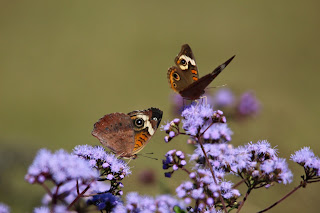Saturday, October 12:
Last Saturday was the day of the BIG SIT! We had a lot of fun with and assistance from several long time volunteers at the Kiptopeke Hawkwatch: Betsy Foster, Chris Foster, Harry Armistead, Paul Shanahan, Rose Leong, Steve Thornhill, and Wes Hetrick. Anna and I would like to thank them so much for all their help! We counted 66 species from our location on the hawkwatch platform. Some of the highlights included four Eastern Meadowlarks (FOS), two Common Nighthawks, one Yellow-billed Cuckoo, one Blue Grosbeak, and one Rose-breasted Grosbeak. It was a pleasant day overall, with 414 total raptors counted.
We had some interesting non-avian sightings, including a few Red Admirals visiting our hummingbird feeder. We are continuing to maintain these feeders even though the Ruby-throated Hummingbirds have moved on for now. We do this just in case some unusual species decides to show up... and it turns out to have paid off, although not in the way we were expecting. It is very nice to see that the butterflies are appreciating our efforts to feed any little pollinator that could use an easy meal.
As we are getting further into the migration season, we are starting to see more species that are known for arriving at this time of October. One of these is the Eastern Phoebe. We are also seeing groups of Blue Jays and Eastern Bluebirds.
Red Admiral Butterflies at our Hummingbird Feeder (Megan Murante)
Juvenile Eastern Rat Snake (Megan Murante)
Eastern Phoebe (Megan Murante)
Eastern Phoebe (Megan Murante)
Jerry Garcia (our beloved resident Mockingbird) taking a bath (Megan Murante)
Sunday, October 13:
On Sunday we had 849 raptors, which is a great total for this time in the season. The typical peak of the migration is over, so we were all astonished when hundreds of accipiters started flying over. There were 519 Sharp-shinned Hawks and 176 Cooper's Hawks, many of which flew very low over the platform, allowing for excellent looks. The majority of the birds passed through in the morning, and the numbers fell rapidly in the afternoon as the weather worsened and there were light sprinkles in the afternoon. I led an additional early bird nature walk on Sunday, and as we were walking my group kept pointing out accipiter after accipiter flying over the trails!
Broad-winged Hawk (Megan Murante)
Peregrine Falcon (Megan Murante)
Cooper's Hawk (Megan Murante)
American Kestrel (Megan Murante)
Peregrine Falcon (Megan Murante)
Sharp-shinned Hawk (Megan Murante)
Monday, October 14:
Monday was a pretty incredible day. The morning started on a very thrilling note. An immature or adult female Painted Bunting was seen and photographed by Anna in the holly and cherry trees near the platform. Unfortunately this rare bird vanished shortly after it was first seen. We imagine that "Jerry" the mockingbird decided that the bunting was spending too much time in "his" cherry tree and chased it away. Other interesting non raptors of the day included a Common Loon, a Dickcissel (FOS), and a Red-headed Woodpecker.
In the afternoon I was able to find a "rosa" buckeye butterfly that had flown away when I was trying to photograph it two days prior. Monarchs aren't the only species of butterflies that migrate through Kiptopeke, but Common Buckeyes do too. We have been looking at the buckeyes that visit our butterfly garden in the hope that we will see a "rosa". This variation of Common Buckeye is found in the fall, and there is not a lot of information about it. The key characteristic of a "rosa" is that the underside of the wing is a shade of pink or purple.
There was a decent flight of raptors and we ended the day with 239 total. We were enthralled by a Merlin that found a perfect hunting ground in the field next to the platform. The Merlin repeatedly swooped down to catch an insect and then would fly up to the t-pole in the middle of the field to eat. A few times it caught an unsuspecting bug so close to us that we could actually hear the "crunch" as its talons snapped around the target! I recorded the Merlin for a short while as it sat on the t-pole eating, and you can view the highlights of it's activities here.
Red Admiral (Megan Murante)
Painted Bunting photographed from the Hawkwatch Platform (Anna Stunkel)
Common Yellowthroat (Megan Murante)
Ruby-crowned Kinglet (Megan Murante)
Rosa Common Buckeye (Megan Murante)
Topside of "rosa" buckeye (Megan Murante)
*Note the darker upper side and the light blue in between the orange stripes at the top of the wing close to the head. When comparing it with other Common Buckeyes in the garden, I noticed that none of the others had that light blue. I wonder if the color variation also extends to the top of the wing, not just the underside.
Merlin returning to the t-pole after snatching a snack (Megan Murante)
Coming in for the landing
A flawless approach...
The Merlin sticks the landing, a perfect ten! (Megan Murante)
Tuesday, October 15:
Baltimore Oriole (Megan Murante)
A less extreme "rosa" buckeye next to a common (Megan Murante)
*On the common variation (the one on the right) there isn't any blue in between the orange stripes. I have noticed slight variation between even common variation butterfly colors, but none of the non-rosa butterflies I have seen have had that blue.
Red-tailed Hawk (Megan Murante)
Cooper's Hawk (Megan Murante)
Bald Eagle (Megan Murante)
-Megan



























